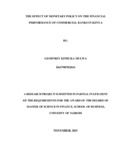| dc.description.abstract | Monetary policy is one of the principal economic management tools that the government uses to shape economic performance. The government through the Central Bank uses monetary policy tools like open market operations, central bank rate and cash reserve ratio for commercial banks with the objective of managing multiple monetary targets among them price stability, promotion of growth, achieving full employment, smoothing the business cycle, preventing financial crises, stabilizing long-term interest rates and the real exchange rate. Commercial banks act as a mediator for the Central Bank in implementing these tools and hence the basis for this study. This study was carried out with the following objectives; to establish the effect of Central Bank‟s open market operations on the financial performance of Commercial Banks; to establish the effect of Central Bank Rate (CBR) on the financial performance of Commercial Banks and to establish the effect of Reserve Ratio Requirement on the financial performance of Commercial Banks. The study adopted descriptive research design. The target population of this study was commercial banks operating in Kenya and regulated by the Central Bank of Kenya as at 31st December 2014. For the purpose of this study, only secondary data was used. The secondary data was sourced from the Financial Statements of the commercial Banks that are available from their websites and Central Bank of Kenya Publications. Data was collected for a period of five years from 2010 to 2014. Data was analyzed using Statistical Package for Social Sciences (SPSS) version 16. The study then used descriptive statistics and inferential statistics to establish the relationship between monetary policies tools and the financial performance of commercial banks in Kenya. The study used Net Interest Margin as the measure for financial performance for the banks. The results showed that the model explained 17.7% of the variance in financial performance of commercial banks as given by the value of R2. The model was also fit to explain the relationship as the F-Statistic of 5.581 was significant at 5% level, p=0.000. The study established that monetary policy tools as represented by open market operation β=0.506, p=0.608, CBR, β=-0.221, p=0.687, and cash reserve ratio, β=-4.349, p=0.622, have no significant effect on the financial performance of commercial banks in Kenya. Bank size was however found to have a weak positive effect, β = 0.009, p <0.0, on financial performance of commercial banks in Kenya. The study concludes that monetary policy tools employed by the central bank of Kenya do not have a significant effect on the financial performance of commercial banks in Kenya. The study therefore recommends that commercial banks need to focus more on the internal factors that affect financial performance of commercial banks as have been identified in other studies. The study further recommends that commercial banks should focus on monetary policy changes to the extent of complying with the Central Bank guidelines and adjusting their variables accordingly. This is a matter of management efficiency. | en_US |

